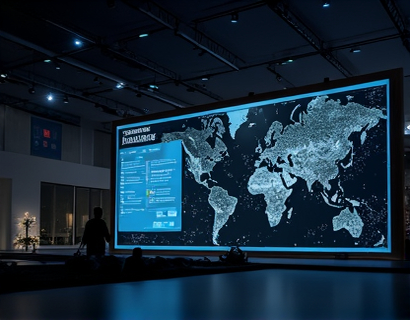Unlocking Engagement: The Next Evolution of QR Codes for Business and Social Media Success
In the rapidly evolving digital landscape, businesses and social media managers are constantly seeking innovative ways to engage their audiences. One of the most transformative tools in this quest is the QR code. Originally designed for inventory management, QR codes have undergone a significant evolution, emerging as a powerful engagement solution for businesses and social media platforms. This article explores the next generation of QR codes, focusing on their customizable features, user-friendly interfaces, and the potential they hold for enhancing customer interaction.
The Rise of QR Codes in Business
QR codes have gained immense popularity in recent years, particularly during the COVID-19 pandemic, when contactless solutions became essential. Businesses across various sectors have adopted QR codes to facilitate seamless interactions with customers. From restaurants offering digital menus to retailers providing quick access to product information, the versatility of QR codes has made them a staple in modern marketing strategies.
Understanding the Next Generation of QR Codes
The next evolution of QR codes goes beyond simple black-and-white squares. These advanced codes are designed to be customizable and intuitive, allowing businesses to create unique experiences for their customers. Here are some key features that define the next generation of QR codes:
- Customizable Designs: Businesses can now create QR codes that reflect their brand identity. This includes incorporating logos, colors, and even images into the code, making it visually appealing and recognizable.
- Dynamic QR Codes: Unlike static QR codes, which link to a fixed URL, dynamic QR codes can be edited after creation. This means businesses can change the destination URL without needing to generate a new code, allowing for flexibility in marketing campaigns.
- Analytics and Tracking: Advanced QR codes come equipped with analytics tools that provide insights into user interactions. Businesses can track how many times a code has been scanned, the location of scans, and the devices used, enabling data-driven decision-making.
- Integration with Social Media: The next generation of QR codes can seamlessly integrate with social media platforms, allowing businesses to direct users to their profiles, promotional content, or user-generated content.
- Enhanced User Experience: With features like instant access to information, multimedia content, and interactive elements, these QR codes enhance the overall user experience, making it easier for customers to engage with brands.
Benefits of Using Next-Generation QR Codes
Implementing next-generation QR codes offers numerous benefits for businesses and social media managers. Here are some of the most significant advantages:
1. Improved Customer Engagement
Next-generation QR codes facilitate direct interaction between businesses and customers. By scanning a code, users can access exclusive content, promotions, or product information, fostering a deeper connection with the brand. This immediate access to information enhances the customer experience and encourages engagement.
2. Streamlined Information Sharing
In a world where consumers are inundated with information, simplicity is key. QR codes provide a quick and efficient way to share information. Whether it’s a link to a website, a video, or a digital brochure, QR codes eliminate the need for lengthy URLs or complicated instructions, making it easier for customers to access what they need.
3. Cost-Effective Marketing Tool
Creating and implementing QR codes is a cost-effective marketing strategy. Businesses can generate QR codes for free or at a minimal cost, and they can be printed on various materials, including business cards, flyers, and packaging. This affordability makes QR codes an attractive option for businesses of all sizes.
4. Enhanced Brand Visibility
Customizable QR codes allow businesses to incorporate their branding elements, making them more recognizable. When customers see a branded QR code, they are more likely to engage with it, leading to increased brand visibility and awareness.
5. Data-Driven Insights
The analytics capabilities of next-generation QR codes provide valuable insights into customer behavior. Businesses can analyze scan data to understand their audience better, tailor marketing strategies, and improve overall engagement efforts.
Implementing QR Codes in Your Marketing Strategy
To effectively leverage next-generation QR codes, businesses should consider the following steps:
1. Define Your Goals
Before implementing QR codes, it’s essential to define your marketing goals. Are you looking to increase website traffic, promote a new product, or enhance customer engagement? Understanding your objectives will help you create targeted QR code campaigns.
2. Choose the Right QR Code Type
Depending on your goals, select the appropriate type of QR code. For instance, if you want to direct users to a specific landing page, a dynamic QR code is ideal. If you’re looking to share contact information, a vCard QR code may be more suitable.
3. Design Your QR Code
Utilize customizable features to design a QR code that aligns with your brand. Incorporate your logo, choose colors that match your branding, and ensure the code is visually appealing. A well-designed QR code is more likely to attract attention and encourage scans.
4. Promote Your QR Code
Once your QR code is ready, promote it across various channels. Include it in print materials, social media posts, email newsletters, and on your website. The more visibility your QR code receives, the higher the chances of engagement.
5. Monitor and Analyze Performance
After launching your QR code campaign, monitor its performance using the analytics tools provided. Analyze the data to understand user behavior, identify trends, and make informed decisions for future campaigns.
Case Studies: Successful QR Code Implementations
To illustrate the effectiveness of next-generation QR codes, let’s explore a few case studies of businesses that have successfully implemented these codes in their marketing strategies.
Case Study 1: Restaurant Industry
A local restaurant implemented QR codes to provide customers with digital menus. By placing QR codes on tables and at the entrance, customers could easily access the menu on their smartphones. This not only enhanced the dining experience but also reduced the need for physical menus, aligning with health and safety guidelines during the pandemic. The restaurant reported a 30% increase in customer engagement and positive feedback regarding the convenience of the digital menu.
Case Study 2: Retail Sector
A clothing retailer utilized dynamic QR codes in their marketing campaigns. Each code linked to a specific product page, allowing customers to quickly access product details, sizes, and colors. The retailer also incorporated QR codes into their social media posts, directing users to exclusive promotions. As a result, the retailer saw a 25% increase in online sales and a significant boost in social media engagement.
Case Study 3: Event Marketing
An event organizer used QR codes to streamline the ticketing process for a large conference. Attendees received QR codes via email, which they could scan at the entrance for quick check-in. Additionally, QR codes were placed throughout the venue, providing information about sessions, speakers, and exhibitors. The organizer reported a smoother check-in process and positive feedback from attendees regarding the ease of accessing event information.
Future Trends in QR Code Technology
As technology continues to advance, the future of QR codes looks promising. Here are some trends to watch for in the coming years:
1. Increased Integration with Augmented Reality (AR)
As AR technology becomes more mainstream, we can expect to see QR codes integrated with AR experiences. This could allow users to scan a code and view 3D models of products, interactive content, or immersive brand experiences, further enhancing engagement.
2. Enhanced Security Features
With the rise of digital transactions, security is a top concern for consumers. Future QR codes may incorporate advanced security features, such as encryption and authentication, to ensure safe interactions and build trust with users.
3. Greater Personalization
As businesses collect more data on customer preferences, QR codes may become more personalized. Users could receive tailored content based on their previous interactions, creating a more engaging and relevant experience.
4. Broader Adoption Across Industries
While QR codes have gained traction in specific sectors, their adoption is expected to expand across various industries. From healthcare to education, businesses will continue to explore innovative ways to utilize QR codes for engagement and information sharing.
Conclusion
The next evolution of QR codes presents a unique opportunity for businesses and social media managers to enhance engagement and build stronger connections with their audiences. By leveraging customizable, user-friendly QR code solutions, brands can simplify information sharing, boost customer interaction, and stand out in the competitive digital landscape. As technology continues to advance, the potential for QR codes will only grow, making them an essential tool for businesses looking to thrive in the future.










































